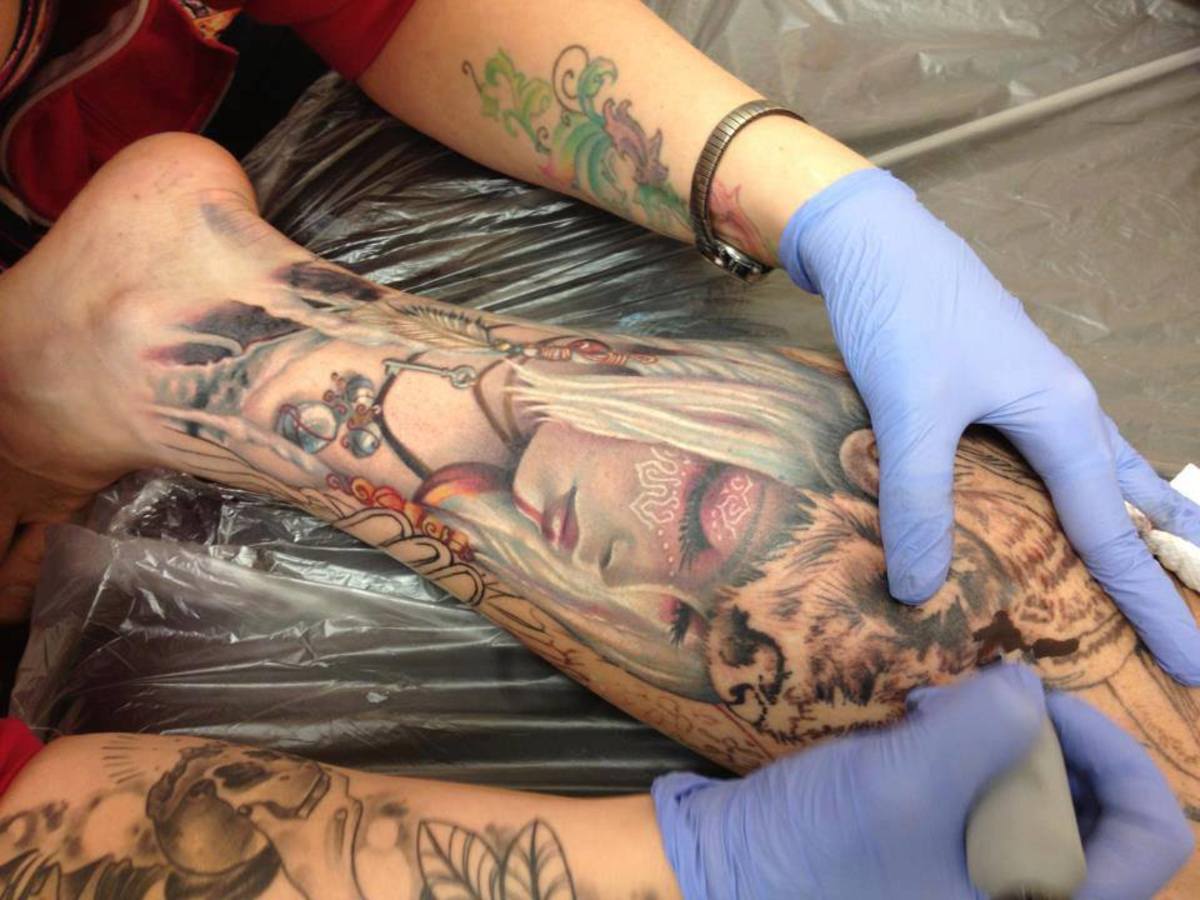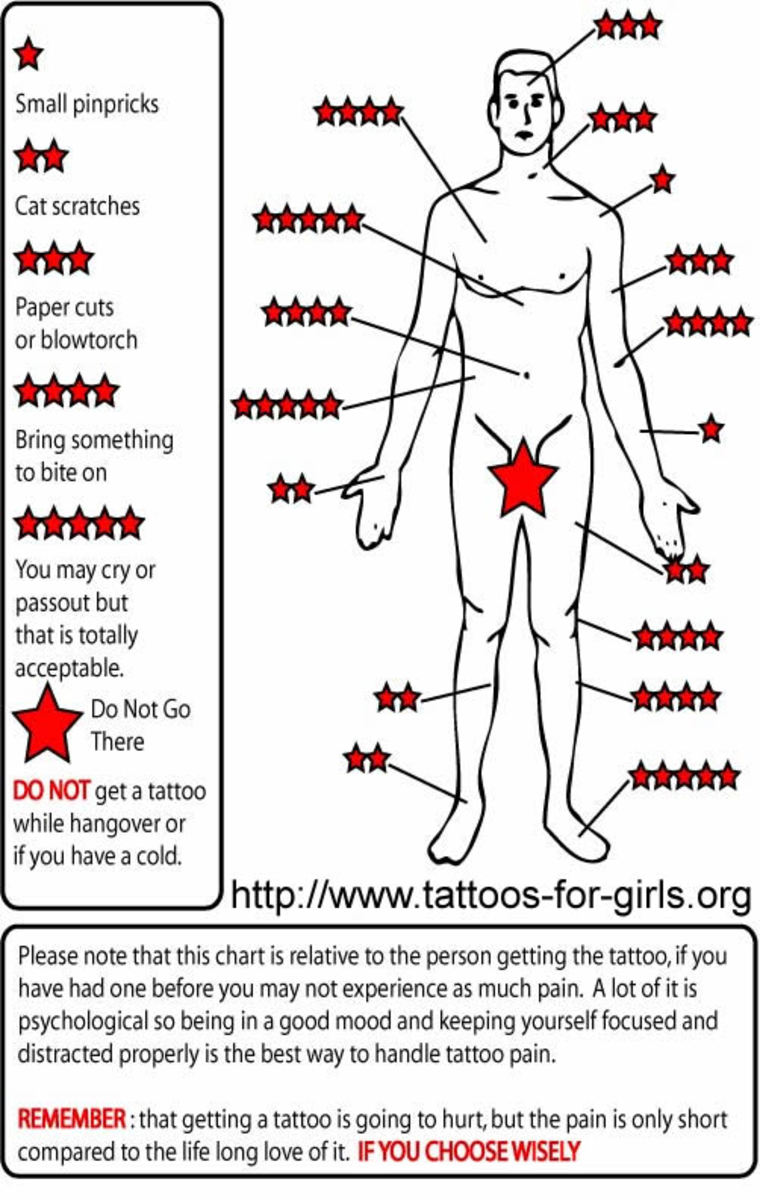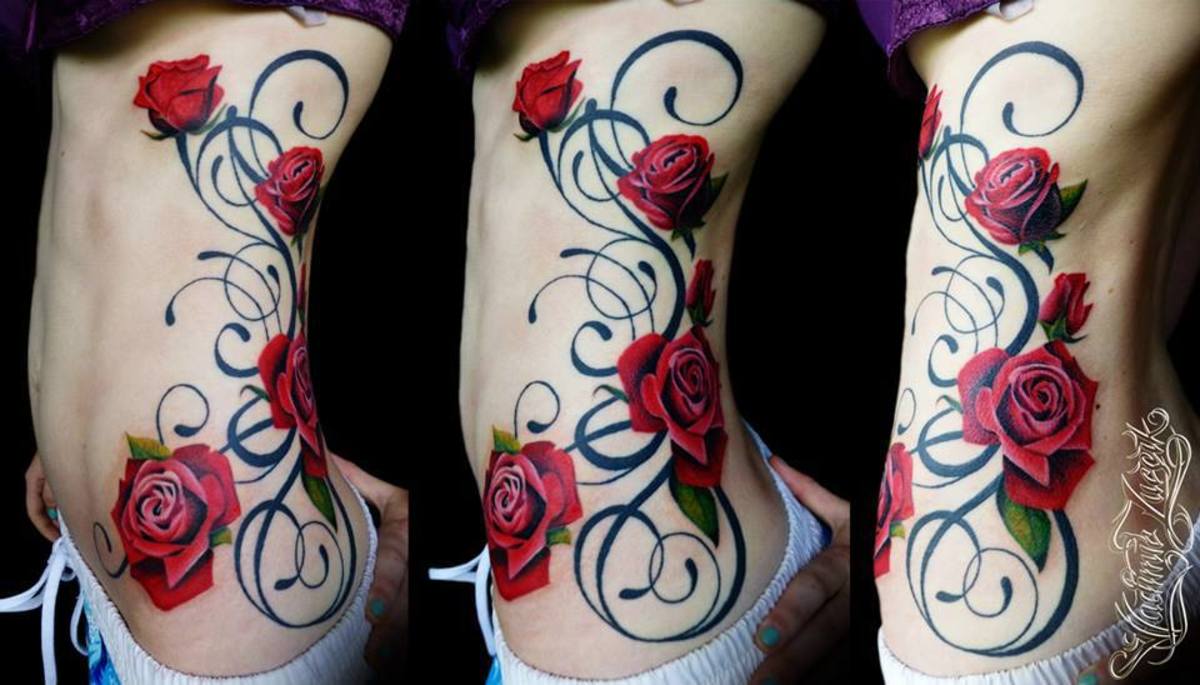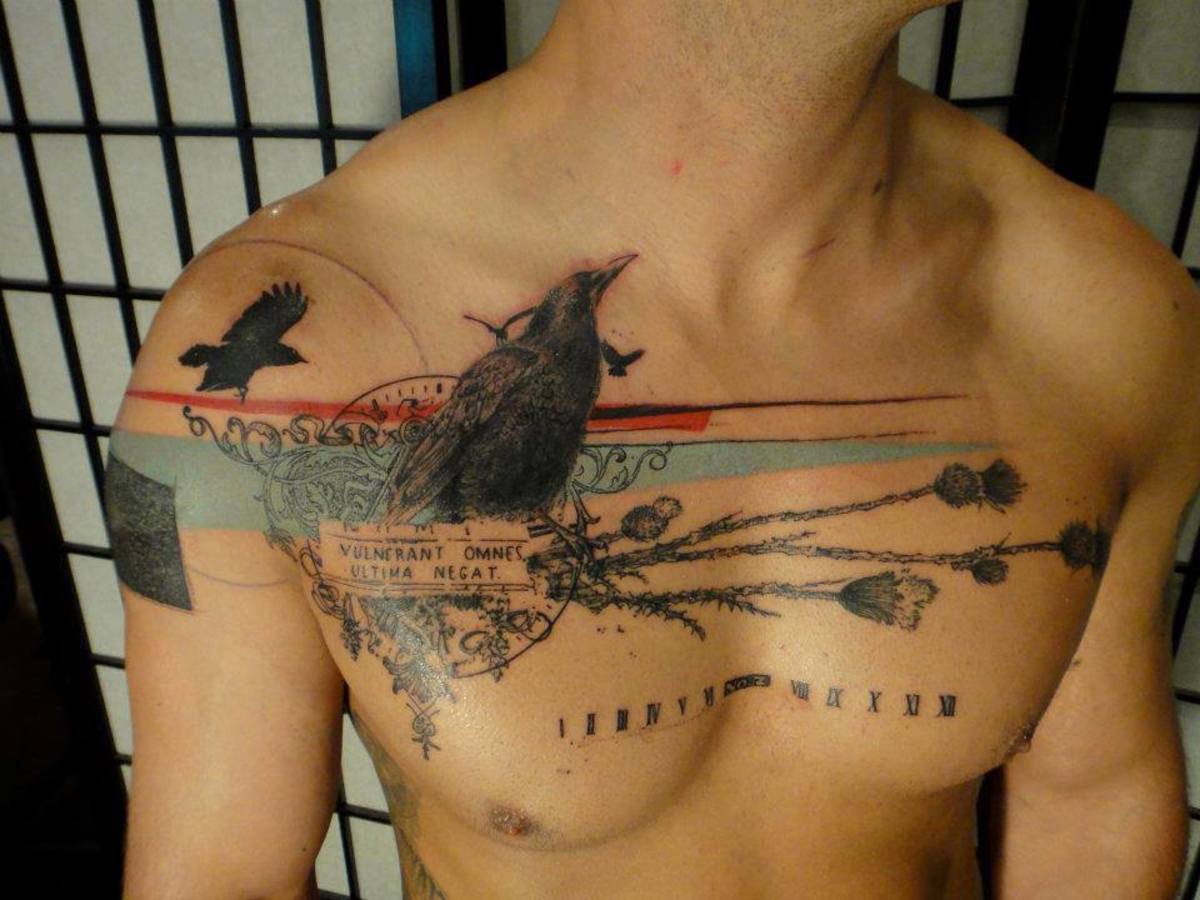
Does it hurt to get a tattoo? Learn about pain and your tattoo. | Source
Many people who proudly
display tattoos say they are a way of expressing themselves, decorating
their bodies and recording the stories of their life. Whatever your
reason is for wanting a tattoo, there is always one question that goes
through your mind . . . Does it really hurt to get a tattoo?
Maybe you've heard horror stories about the pain, or you have heard about someone who fell asleep on the table. So it comes as no surprise that the truth is somewhere in between those two extremes.
There are many pain filled horror stories floating about and legends as well. Either it hurt like hell or the 'legends', simply fell asleep while being tattooed. It's really no surprise that the truth, is somewhere in between.
The reality is that getting a tattoo is a uniquely personal experience and there are many factors that contribute towards making it either a pleasant or painful one.
Maybe you've heard horror stories about the pain, or you have heard about someone who fell asleep on the table. So it comes as no surprise that the truth is somewhere in between those two extremes.
There are many pain filled horror stories floating about and legends as well. Either it hurt like hell or the 'legends', simply fell asleep while being tattooed. It's really no surprise that the truth, is somewhere in between.
The reality is that getting a tattoo is a uniquely personal experience and there are many factors that contribute towards making it either a pleasant or painful one.
Premium Tattoo Aftercare Box
Does it Really Hurt to Get a Tattoo and Why?
The short answer is yes. It does hurt to get a tattoo.
When you're sitting for a tattoo, a specially designed tattoo needle pierces through your skin at approximately 10-15 needle drops per second, fast enough to avoid puncturing the skin and causing bleeding and slow enough to avoid tearing the skin.
Your skin has three layers, the epidermis, the dermis and the hypodermis. Because the epidermis is constantly replenishing itself, the tattoo needle needs to penetrate through the dermis layer to make the tattoo permanent. For this to occur, the tip of the needle attached to the tattoo machine is entering your skin layers approximately 1/16" of an inch.
When you're sitting for a tattoo, a specially designed tattoo needle pierces through your skin at approximately 10-15 needle drops per second, fast enough to avoid puncturing the skin and causing bleeding and slow enough to avoid tearing the skin.
Your skin has three layers, the epidermis, the dermis and the hypodermis. Because the epidermis is constantly replenishing itself, the tattoo needle needs to penetrate through the dermis layer to make the tattoo permanent. For this to occur, the tip of the needle attached to the tattoo machine is entering your skin layers approximately 1/16" of an inch.

Tattoo pain intensity chart. Find out how much a tattoo hurts and how to stop the pain.
Which Part of the Body Hurts the Most?
Though
everyone is different and can withstand different amounts of pain,
there are some areas of the body where getting a tattoo is not as
painful as other locations. Keep in mind that the pain you will
experience is relative to you. If you're sensitive to pain, and your
desired area for a tattoo is known to be painful, it might make sense to
choose a different location.
Some more sensitive or painful parts of the body to tattoo are:
Furthermore, the healing process can be just as painful as getting the tattoo itself and you might need to take some time off from your usual routine.
The most sensitive parts of the body to tattoo are:
Least Amount of Pain Body Locations
The least irritating places to get tattoos are:- Upper outside of arm and outer forearm
- Inner wrist
- Calves
- Shoulders
- Upper back (excluding spine area)
- Top and outer thigh
Medium Amount of Pain or Mixed Reviews
In some of these parts of the body, there is a lot of movement like the ankle and inner arm and may take longer for them to heal. Some people report these areas as being very painful, and others don't. It just depends on your body. If you are thinner, you'll probably find these areas more painful.Some more sensitive or painful parts of the body to tattoo are:
- Neck
- Inner arm (with exceptions)
- Centre back
- Head
- Lower back
- Ankle
Significant Amount of Pain
There are some areas that are known to generally be very painful to tattoo. Make sure you're prepared to withstand it before getting the tattoo! Tattooing directly on bony bits like the elbow or knees can be torturous. You feel as though the whole bone is vibrating and sometimes the adjoining bone too.Furthermore, the healing process can be just as painful as getting the tattoo itself and you might need to take some time off from your usual routine.
The most sensitive parts of the body to tattoo are:
- Hips
- Stomach
- Back of knees
- Armpit
- Inside of elbow
- Nipples
- Lips
- Top of foot
- Any joint areas (Insides particularly)
- Lower chest and sides (It feels like the tattooist is working under your armpit! Not a nice feeling!)

Male, greyscale tattoo sleeve. Do tattoos hurt? Find out how much. | Source
Help yourself have a more enjoyable tattoo session by following some of the tips below.
The Do's of Getting a Tattoo and Minimizing Pain
- Have a good, filling meal at least an hour before your tattoo begins.
- Drink plenty of water to avoid dehydration before and during the tattoo session.
- Wear comfortable clothing for sitting a long time and a piece of clothing that exposes comfortably the part of the body that you want to have tattooed.
- Sleep a full night's sleep the night before (no big parties!)
- Take some mild pain killers like paracetamol with you just in case (avoid aspirin and other drugs that can thin the blood).
- Ask your artist about skin-numbing creams and if they recommend them for you or not.
- Listen to what your tattoo artist advises regarding aftercare; they usually know best.
- Bring lollies, breath mints, and food to munch on during the session to keep your energy levels up.
- Have a shower and wash before you go. Don't overdo the perfume or deodorant.
- Bring some music and earphones in case you want to zone out.
- Consider your tattoo to be similar to a minor medical procedure and go easy on your body afterwards.
- Have an effective aftercare routine in mind and have the necessary antibacterial soaps and cream and lotions purchased before you get your tattoo as you'll need them within an hour of finishing your tattoo session.
The Do Not's
- Avoid drinking alcohol the night before your tattoo as it thins the blood and hinders the body's natural ability to seal a wound and prevent infections.
- Avoid drinking more than one coffee the morning before your tattoo since it also thins the blood.
- If you don't know what design you really want, don't get a tattoo!
- If you don't see clean equipment and new needles at the parlor, don't go through with the tattoo.
- Don't get a tattoo when you are sick. You could infect other people and your body won't be able to heal itself as well.
- Don't drink or take drugs before your tattoo session as they increase heart rate and thin the blood.
- Avoid taking more than one person with you for support. Getting a tattoo is not that emotionally damaging and space at the studio is often limited.
- Don't have a heap of photos taken of your tattoo in action. It could distract the artist and they may make an error.

More Information on Getting a Tattoo
- Top 50 Tattoo Quotes
A selection of the best tattoo quotes available. Top 50 quotes of all time. - Reducing the Pain of Tattoos with Numbing Cream
Numbing cream can help reduce pain while getting a tattoo. Learn more about numbing creams, what they do, and how they work.
How Long Will My Tattoo Take?
Sitting for your tattoo is not generally very much fun, though it can be exciting.
Tattoo sessions last for three to four hours on average.Generally, this is a standard session for both the client and the artists comfort equally. Keep in mind, they are bending over you, grasping a tattoo machine for as long as you're sitting there getting tattooed. This is enough time that both the client and the artist, should be able to stay relatively comfortable.
Once a person has experienced getting a tattoo, it's not uncommon for them to sit for longer lengths of time. However, this can (in some cases) be counter-productive since the skin can experience greater trauma, which hinders healing and might need touch-ups later on.
If your design is very small it could be finished in as little as 20 minutes. Even so, you will most likely be charged at a full hour's rate to cover the costs of the studio, artist and equipment used since the set-up cost is pretty much the same whether it's a 20-minute or two-hour tattoo.
Large, detailed designs can take multiple sittings and many hours. For the more dedicated, a long session can go anywhere from five to eight hours. However, if it's tattooed for too long, the body will often go into shock. You might notice you're shivering and that the tattoo hurts a lot more than it did half an hour ago. When this happens, it's time to go home. You've hit the wall and you're only going to go downhill from here.
However, as in most situations in this crazy thing called life, everyone is unique; people will be able to sit for varying lengths of time before they hit the proverbial wall.
No matter the setup, you can be sure that you won't be moving around for quite some time. The artist will position you on a bed or chair that is similar to what you might see in a doctor's or dentist's office and is usually covered in plastic wrap for cleanliness.
You'll need to maintain your position for as long as the artist needs you to in order to finish the design. That said, do let the artist know if you're cramping or begin to experience any discomfort. They might be able to work with you in order to find a more comfortable position.
Tattoo sessions last for three to four hours on average.Generally, this is a standard session for both the client and the artists comfort equally. Keep in mind, they are bending over you, grasping a tattoo machine for as long as you're sitting there getting tattooed. This is enough time that both the client and the artist, should be able to stay relatively comfortable.
Once a person has experienced getting a tattoo, it's not uncommon for them to sit for longer lengths of time. However, this can (in some cases) be counter-productive since the skin can experience greater trauma, which hinders healing and might need touch-ups later on.
If your design is very small it could be finished in as little as 20 minutes. Even so, you will most likely be charged at a full hour's rate to cover the costs of the studio, artist and equipment used since the set-up cost is pretty much the same whether it's a 20-minute or two-hour tattoo.
Large, detailed designs can take multiple sittings and many hours. For the more dedicated, a long session can go anywhere from five to eight hours. However, if it's tattooed for too long, the body will often go into shock. You might notice you're shivering and that the tattoo hurts a lot more than it did half an hour ago. When this happens, it's time to go home. You've hit the wall and you're only going to go downhill from here.
However, as in most situations in this crazy thing called life, everyone is unique; people will be able to sit for varying lengths of time before they hit the proverbial wall.
What Happens During a Tattoo Session?
Your session could either be in a private cubicle or in an open room with other artists and clients. You can request a privacy screen if you feel uncomfortable with other people around or if you have to reveal a private area while getting a tattoo.No matter the setup, you can be sure that you won't be moving around for quite some time. The artist will position you on a bed or chair that is similar to what you might see in a doctor's or dentist's office and is usually covered in plastic wrap for cleanliness.
You'll need to maintain your position for as long as the artist needs you to in order to finish the design. That said, do let the artist know if you're cramping or begin to experience any discomfort. They might be able to work with you in order to find a more comfortable position.

Male, Chest Tattoo. The pain experienced on a chest is medium.

Post a Comment